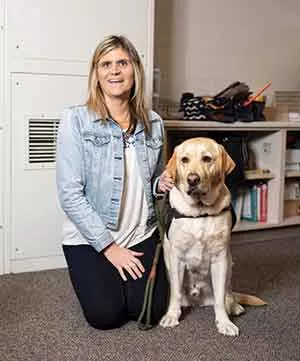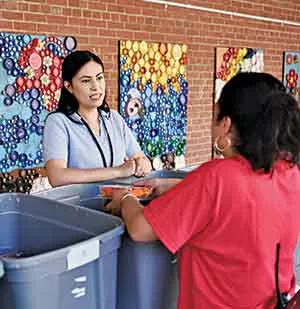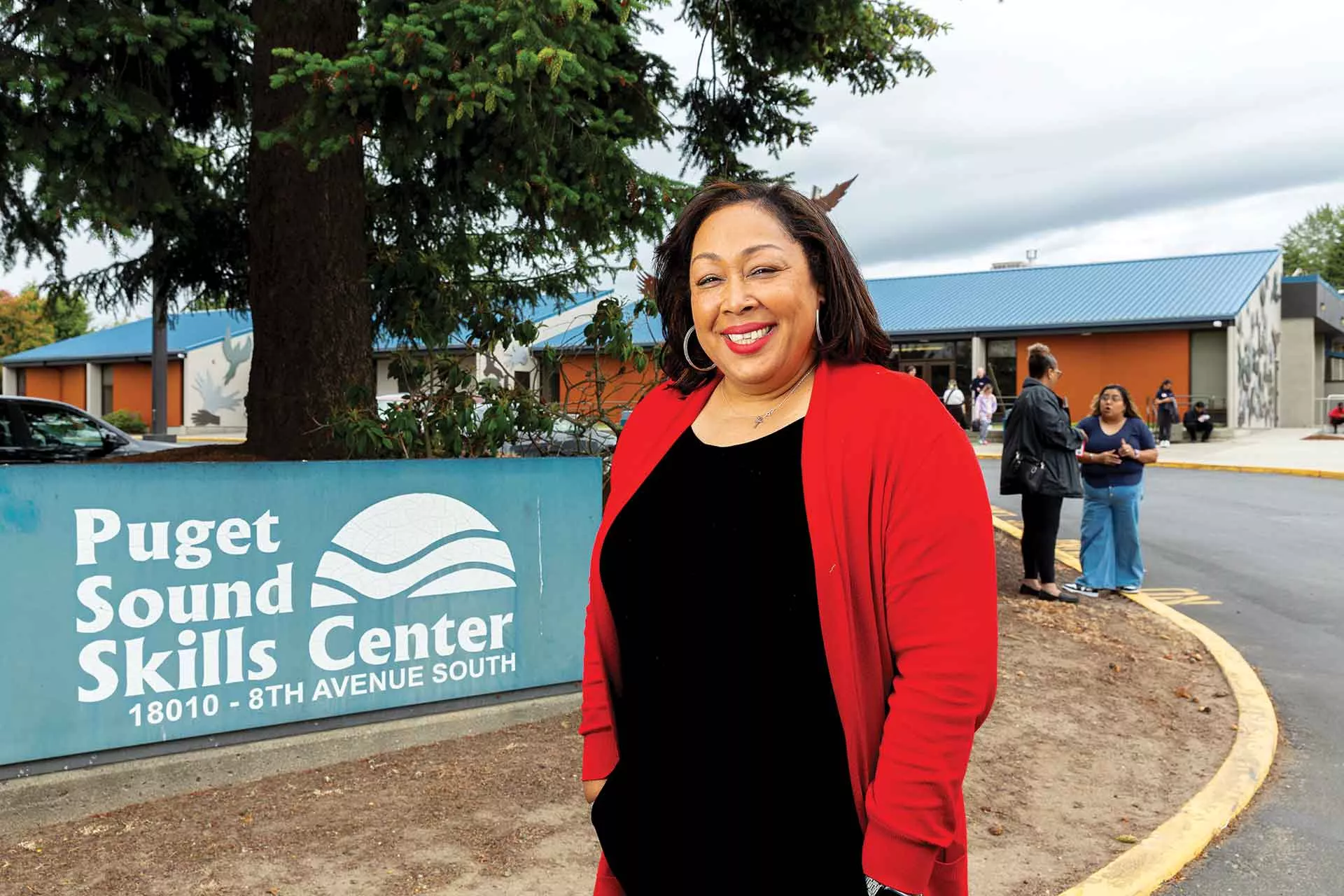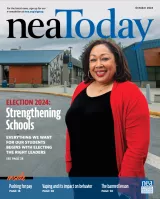From more school counselor and social workers to universal meals and student loan forgiveness, NEA members have seen transformative changes in their schools and in their lives thanks to unprecedented investments by the Biden-Harris administration and the members of Congress who support public education.
The American Rescue Plan (ARP), which President Joe Biden championed and signed into law in 2021, provided the single-biggest investment in public schools in our nation’s history—delivering nearly $170 billion to states to address students’ needs. Among the greatest necessities: mental health supports.
The Biden administration listened to educators and later dedicated nearly $1 billion more to school-based mental health resources for students.
Biden has vowed to continue his work to support public schools and educators in a second term, but he can’t do it alone. This November, it’s critical that we elect leaders to Congress, statehouses, and school boards across the country who share our belief that all students deserve a well-resourced, properly staffed public school where they feel safe and ready to learn.
Here are some NEA members’ stories about how federal dollars made a difference in the lives of our students—proof that elections do matter!
Prioritizing mental health
WASHINGTON
Like every other state across the country, Washington saw students’ mental health needs grow exponentially during the pandemic. “It forced us, as a district and as an entire state, to ask what social-emotional support should really look like,” says Shawna Moore, the dean of student success at the Puget Sound Skills Center, in SeaTac, Wash.
Districts used some of the state’s $1.85 billion in ARP funding for education to hire additional school counselors, psychologists, and social workers, and to provide training for educators on social and emotional learning.
Those resources also helped kickstart critical conversations about race and equity—key factors impacting students’ mental health.
The Washington Education Association was at the forefront of this work, supporting its locals with tools and resources to engage with administrators.
“When you talk about addressing student needs, you have to step back and look at everything,” Moore says. “If we have an inclusion policy, but kids aren’t feeling included, then what are we doing? If we have an anti-discrimination policy, but students are facing some kind of discrimination, what are we doing?”
As vice president of the Highline Education Association, Moore helped establish the Highline Equity and Anti-Racist Team, which brings together union members and administrators to examine how every practice affects students. The district also helped each school create its own equity team.
Electing leaders who will continue to invest in public schools is critical to improve student mental health and well-being, says Moore.
“It takes resources to make sure that every one of our students is seen and heard and valued. That’s huge.”
Quote byGloria Suarez-Aviles , Community schools coordinator, North Carolina
MICHIGAN
Michigan also used ARP funding to address long-standing student mental health needs that grew during the pandemic.
“There’s no question our students need a strong support system at school, starting with a team of mental health professionals,” says Karen Storey, who heads up the Brighton School District’s multitiered system of support. “And there’s a special role that therapy dogs can play to keep students’ day-to-day stressors in check.”

When Storey launched the program in 2009, long before the pandemic, students benefited immediately. Students who were too anxious to leave their buses eagerly rush down the stairs to greet the dog at the curb. The emotional and educational benefits of the therapy dogs were immediately evident. “Even the most reluctant readers will read to the dogs,” Storey says. “There’s no judgment there.”
After the school lost a student to suicide in 2015, Brighton’s canine staff expanded to 15.
Then, as student mental health suffered during the pandemic, Michigan districts used ARP funding to expand the Pack of Dogs program to 52 counties.
Colorado, Oklahoma, and Virginia used ARP resources to launch therapy dog pro-grams of their own.
Since ARP funds became available, mental health has been one of the top three school spending categories nationally. A 2022 survey by the School Superintendents Association found that 82 percent of districts planned to use ARP dollars to expand programs that foster social, emotional, mental, and physical health and development.
“Some of our locals are writing support for therapy dogs into their contracts to make sure their programs live on,” Storey says. “Everyone wraps their arms around this once they see the benefits.”
Ensuring all hungry students are fed
NEVADA
Elizabeth Martinez, the director of nutrition services for Nevada’s Carson City Schools, says having universal school meals for the last three academic years “has been transformative” for the entire school community.
All schools had funding for universal meals through the 2021–2022 school year, reaching 5 million more students than before the pandemic. Nevada used some of its ARP funding to continue providing school meals for all students for the next two academic years.
Martinez explains that universal school meals changed things overnight for students and families, as well as her staff.

“I work with the most amazing people who just have the biggest hearts,” says Martinez, who oversees 42 workers across 11 kitchens. “It was so hard on them to have to take away a meal from a student who couldn’t pay for it,” she says. “All of that goes away with universal school meals.”
Staff time no longer had to go toward sending letters to families about students’ negative lunch account balances. No longer did teachers see behavior issues from students who were going hungry or being embarrassed in the cafeteria.
The number of meals served in the dis-trict before the pandemic, roughly 700,000 per year, increased to over a million once universal meals went into effect.
“So many more students took advantage of it,” she says. “That really speaks to the need in Carson City and how much uni-versal meals help.” She hopes that lesson is not lost on state and federal lawmakers, who will make decisions about whether to extend universal meal programs.
“The income limits to qualify for free and reduced-price meals are unrealistic, and we need leaders who understand that,” she says. “There’s a lot of unseen need.”
Lifting the weight of student debt
KENTUCKY
High school social studies teacher Tyler Murphy remembers the day last fall when he noticed that his student loan payment wasn’t withdrawn from his bank account as scheduled. He logged into his loan servicer website to figure out what was going on.
“I pulled up my account and it said, ‘Amount owed: $0.’ All the little bars on the payment tracker were filled in green,” Murphy recalls.
For a few moments, he couldn’t believe it. But thanks to Public Service Loan Forgiveness (PSLF)—a priority for the Biden administration—his student debt had been forgiven.
Murphy knew he was on track with his payments, which he had meticulously monitored. Still, he crossed the finish line more quickly than expected because of improvements to PSLF.

Since October 2021, more than 793,000 borrowers serving as public employees have been granted $56.7 billion in student loan forgiveness through PSLF. Biden intends to continue the work to ensure that educators can live without the crushing weight of student debt.
For Murphy, who is starting his seventh year teaching at Boyle County High School, in Danville, Ky., having more than $50,000 in debt forgiven has given him room to breathe.
“I’ve been surprised how much more flexibility it has given me for things like saving for retirement and that elusive goal for my generation, as a millennial, of home ownership,” Murphy says.
“So many borrowers in the past have gotten to the point where the interest is accruing at a rate that makes it essentially impossible for them to ever claw their way out on an educator’s salary,” he says.
“Joe Biden thinks we deserve better,” Murphy adds. “And his efforts reflect that.”
Big academic gains
NORTH CAROLINA
How did Club Boulevard Elementary School, in Durham, N.C., go from struggling academically to leading the district in early-grade reading scores in just a few years’ time?
Every educator was engaged. They leveraged every resource at their disposal to drive toward that goal, including federal ARP dollars as well as Title I—the federal program that supports schools with large numbers of low-income families—which the Biden-Harris administration expanded by $1.9 billion since 2021.

Gloria Suarez-Aviles, the community schools coordinator at Club Boulevard, is one of those staff members who seems to be everywhere. She’s at the drop-off loop to greet students in the morning, on lunch duty in the cafeteria, then coordinating with colleagues and working with small groups of students who need extra support to meet—and exceed—academic expectations.
To help boost early-grade reading skills, Club Boulevard dedicated ARP funding to after-school tutoring provided by the students’ classroom teachers, who already have their second- and third-graders’ trust and know their struggles.
In addition to ongoing supports like the food pantry, the clothing closet, and family check-ins with Ms. Gloria, these tutoring sessions helped catapult Club Boulevard’s reading scores to the top of the district.
Suarez-Avilez says recognizing students who uphold school values and creating clubs that meet during the school day made students feel more connected to their education.
Sign the Pledge to be a Public Education Voter
In 2024, folks across the nation will have the chance to vote for candidates and ballot measures that will secure the future of our democracy and strengthen public education. Show you’re one of them.



